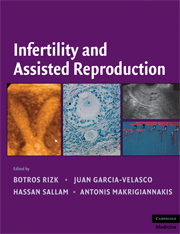Book contents
- Frontmatter
- Contents
- Contributors
- Foreword
- Preface
- Introduction
- PART I PHYSIOLOGY OF REPRODUCTION
- PART II INFERTILITY EVALUATION AND TREATMENT
- 6 Evaluation of the Infertile Female
- 7 Fertiloscopy
- 8 Microlaparoscopy
- 9 Pediatric and Adolescent Gynecologic Laparoscopy
- 10 Laparoscopic Tubal Anastomosis
- 11 Tubal Microsurgery versus Assisted Reproduction
- 12 The Future of Operative Laparoscopy for Infertility
- 13 Operative Hysteroscopy for Uterine Septum
- 14 Laser in Subfertility
- 15 Ultrasonography of the Endometrium for Infertility
- 16 Ultrasonography of the Cervix
- 17 Transrectal Ultrasonography in Male Infertility
- 18 The Basic Semen Analysis: Interpretation and Clinical Application
- 19 Evaluation of Sperm Damage: Beyond the WHO Criteria
- 20 Male Factor Infertility: State of the ART
- 21 Diagnosis and Treatment of Male Ejaculatory Dysfunction
- 22 Ovulation Induction
- 23 Clomiphene Citrate for Ovulation Induction
- 24 Aromatase Inhibitors for Assisted Reproduction
- 25 Pharmacodynamics and Pharmacokinetics of Gonadotrophins
- 26 The Future of Gonadotrophins: Is There Room for Improvement?
- 27 Ovarian Hyperstimulation Syndrome
- 28 Reducing the Risk of High-Order Multiple Pregnancy Due to Ovulation Induction
- 29 Hyperprolactinemia
- 30 Medical Management of Polycystic Ovary Syndrome
- 31 Surgical Management of Polycystic Ovary Syndrome
- 32 Endometriosis-Associated Infertility
- 33 Medical Management of Endometriosis
- 34 Reproductive Surgery for Endometriosis-Associated Infertility
- 35 Congenital Uterine Malformations and Reproduction
- 36 Unexplained Infertility
- 37 “Premature Ovarian Failure”: Characteristics, Diagnosis, and Management
- PART III ASSISTED REPRODUCTION
- PART IV ETHICAL DILEMMAS IN FERTILITY AND ASSISTED REPRODUCTION
- Index
- Plate section
- References
24 - Aromatase Inhibitors for Assisted Reproduction
from PART II - INFERTILITY EVALUATION AND TREATMENT
Published online by Cambridge University Press: 04 August 2010
- Frontmatter
- Contents
- Contributors
- Foreword
- Preface
- Introduction
- PART I PHYSIOLOGY OF REPRODUCTION
- PART II INFERTILITY EVALUATION AND TREATMENT
- 6 Evaluation of the Infertile Female
- 7 Fertiloscopy
- 8 Microlaparoscopy
- 9 Pediatric and Adolescent Gynecologic Laparoscopy
- 10 Laparoscopic Tubal Anastomosis
- 11 Tubal Microsurgery versus Assisted Reproduction
- 12 The Future of Operative Laparoscopy for Infertility
- 13 Operative Hysteroscopy for Uterine Septum
- 14 Laser in Subfertility
- 15 Ultrasonography of the Endometrium for Infertility
- 16 Ultrasonography of the Cervix
- 17 Transrectal Ultrasonography in Male Infertility
- 18 The Basic Semen Analysis: Interpretation and Clinical Application
- 19 Evaluation of Sperm Damage: Beyond the WHO Criteria
- 20 Male Factor Infertility: State of the ART
- 21 Diagnosis and Treatment of Male Ejaculatory Dysfunction
- 22 Ovulation Induction
- 23 Clomiphene Citrate for Ovulation Induction
- 24 Aromatase Inhibitors for Assisted Reproduction
- 25 Pharmacodynamics and Pharmacokinetics of Gonadotrophins
- 26 The Future of Gonadotrophins: Is There Room for Improvement?
- 27 Ovarian Hyperstimulation Syndrome
- 28 Reducing the Risk of High-Order Multiple Pregnancy Due to Ovulation Induction
- 29 Hyperprolactinemia
- 30 Medical Management of Polycystic Ovary Syndrome
- 31 Surgical Management of Polycystic Ovary Syndrome
- 32 Endometriosis-Associated Infertility
- 33 Medical Management of Endometriosis
- 34 Reproductive Surgery for Endometriosis-Associated Infertility
- 35 Congenital Uterine Malformations and Reproduction
- 36 Unexplained Infertility
- 37 “Premature Ovarian Failure”: Characteristics, Diagnosis, and Management
- PART III ASSISTED REPRODUCTION
- PART IV ETHICAL DILEMMAS IN FERTILITY AND ASSISTED REPRODUCTION
- Index
- Plate section
- References
Summary
This chapter discusses the potential role of the new group of medications called “aromatase inhibitors” in assisted reproduction. In the past few years, aromatase inhibitors have emerged as promising agents for infertility treatment, particularly ovarian stimulation. We reported the first series in the literature of the successful application of an aromatase inhibitor for induction of ovulation in women with polycystic ovarian syndrome (PCOS) (1) and ovarian stimulation in women with ovulatory infertility, for example, unexplained infertility (2). Following this report, we showed the success of aromatase inhibition for controlled ovarian hyperstimulation (COH) (3–5), whether as a single- or multiple-dose administration (6), and suggested the potential application in various infertility treatments including assisted reproduction (7–13), with data on safety of the pregnancy outcome (14).
Since these first reports, more than a hundred clinical trials have been presented in international meetings, confirming our original findings, by investigators from all over the globe. Many peer-reviewed manuscripts (15–33) have already confirmed the success of aromatase inhibitors in various infertility applications. Currently, several multicenter clinical trials are running testing the clinical efficacy of aromatase inhibitors for infertility treatment including ovarian stimulation. In this chapter, we will discuss the potential role of aromatase inhibitors for assisted reproduction, presenting the theoretical benefits and the available evidence.
AROMATASE INHIBITORS
Blocking estrogen production by inhibiting the enzyme catalyzing its synthesis from androgens (aromatase enzyme) is a treatment modality that has been in clinical application for more than half a century since the development of the first generations of aromatase inhibitors including aminoglutethimide.
Keywords
- Type
- Chapter
- Information
- Infertility and Assisted Reproduction , pp. 220 - 227Publisher: Cambridge University PressPrint publication year: 2008



